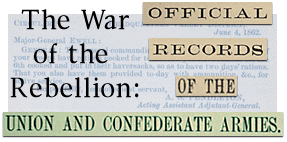Summary:
General Thomas J. Jackson, commanding Confederate forces in the Shenandoah Valley, reports to
Robert E. Lee, directing Confederate operations from Richmond. Jackson outlines the situation
in late April, 1862, and discusses the possibility of Union armies capturing Staunton.
Gen. R. E. LEE,
Cmdg. C. S. Army:
Swift Run Gap,
April 23, 1862.
GEN.:
Your letter of the 21st instant has been received.
Banks' main force is still in the vicinity of New Market, extending from 1 mile below to 3 above the town. Yesterday he had near 100 wagons 12 miles above New Market, and part of his force even entered Harrisonburg, 17 miles from New Market. My object has been to get in his rear at New Market or Harrisonburg if he gives me an opportunity, and this would be the case if that if I remain quiet a few days with his main body. It appears to me that if I remain quiet a few days more he will probably make a move in some direction or send a large force toward Harrisonburg, and thus enable me, with the blessing of Providence, to successfully attack his advance, and if I am unsuccessful in driving back his entire force he may be induced to move forward his command from New Market and attempt to follow me through this gap, where our forces would have greatly the advantage.
Without Gen. Ewell's division Banks can march on to Staunton; though if he attempts it I design threading his flank and rear, and this may prevent his reaching Staunton; but without doing this he can advance so far as to threaten Gen. Edward Johnson's rear so seriously as to make him fall back, and thus let Staunton fall into the hands of the Federal force in his front.
Banks has probably 1,000 men below me on the opposite side of the South Fork of the Shenandoah; but should I attack them, the advantage will be on the side of the enemy, in consequence of the river separating us and a mountain being in their rear, which would enable the enemy to hold me in check until re-enforcements could be brought up from New Market, as it is only 4 miles from the top of the mountain and the river is 8 miles from the top. Under all the circumstances I will direct Gen. Ewell to move forward to Stanardsville, which will enable us in one day to unite all our force at Swift Run Gap or all of his division an my infantry and cavalry at Fisher's Gap, should Banks move in the mean time in that direction, of which I think there is very little prospect. Should he remain in the position of yesterday I will try and seek an opportunity for attacking successfully some part of his army, and, if circumstances justify, press forward.
My instructions from Gen. Johnston were to unite with Gen. Ewell near the top of the Blue ridge and give battle. The course I propose would be departing from Gen. Johnston's instructions, but I do not believe that Banks will follow me to the Blue Ridge unless I first engage him, and I doubt whether he will then.
I have given you my views respecting things here, but it may be that Gen. Ewell could render more service at Fredericksburg, and, if so, I hope that you will direct his movements accordingly.
I am, general, your obedient servant,
T. J. JACKSON,
Maj.-Gen.
Bibliographic Information : Letter Reproduced from The War of The Rebellion: Official Records of the Union and Confederate Armies, Series 1, Volume 12, Serial No. 18, Pages 862-863, Broadfoot Publishing Company, Wilmington, NC, 1997.

